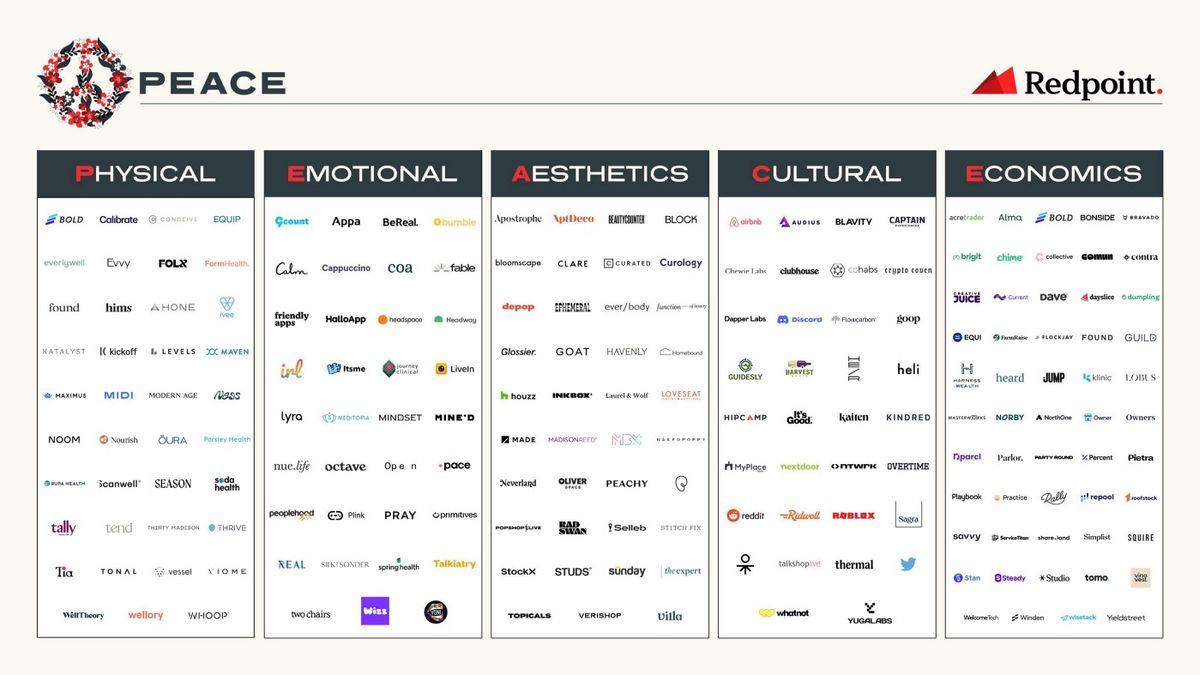Today, we find ourselves at a major inflection, a new “new normal” that will define the years to come. This includes a critical acknowledgement that a new era of discretionary consumption is upon us—supported by data points like the NASDAQ dipping almost 30 percent year-to-date to layoffs and hiring freezes announced with alarming frequency, topped with consumer sentiment plunging to post-crisis lows. Though what consumers are seeking out seems to be changing, the why has stood the test of time: Consumers tend to pursue PEACE, or Physical + Emotional + Aesthetic + Cultural + Economic enlightenment. We at Redpoint are excited to break down the 5 Pillars of PEACE, especially as we remain agile in the face of the ongoing correction.

The Five Pillars of PEACE
Physical: The first pillar, physical enlightenment, focuses on the health of the brain and body. Have you ever heard the phrase, “Your health is your wealth?” While physical health is only one of many components to holistic wellbeing, we suspect consumers will continue to seek wealth in the form of physical health outcomes.
We’ve learned that consumers – even more so than clinicians – dictate overall health. We also know that specific elements of accountability, such as observable outcomes, quantifiable metrics, and social support are all essential in driving engagement and meeting personal health goals. This information makes it easy to picture a future where consumers approach their physical health in an increasingly personalized, preventative, data-driven, and gamified way.
Consumers are turning away from the induced digital daze of pandemic life and towards physical enlightenment opportunities. An explosion in demand for offerings that revolve around diet (whether it be meal logs or food delivery services), sleep, medication access, health supplements, training, coaching, and health and fitness communities, has led consumers have never been more able—or more motivated—to invest in their physical wellbeing.
From supports that can increase overall longevity and help quality of sleep to gut-health supplements and running clubs, we’re excited to underwrite the coming wave of applications paving the path towards physical enlightenment.
Emotional: Emotional enlightenment elicits feelings of acknowledgement, understanding, and support. In other words, emotional enlightenment is about deep connection: to oneself and to others. Balanced emotional health allows individuals to experience a deeper sense of joy, as well as a stronger rebound from adversity.
However, we face a serious problem: though we are able to connect with others online in ways never thought possible – be it gamer groups or crypto cabals – the U.S. is facing a loneliness crisis. Rates of anxiety and depression among U.S. adults have practically quadrupled since 2019. Further, a startling 61% of young people today report feeling lonely “frequently” or “almost all of the time.” Despite the $225Bn annual spending on mental health treatment and services, the supports we can provide to one another through meaningful, socially-oriented engagement remain key to a greater sense of emotional wellbeing for all.
While therapy and other individualized treatments remain important, it is our hope that the next generation of market leaders will increase access to a broader base of consumers. By gradually turning away from isolated and acute interventions, we believe the next wave of emotionally engaging applications will look and feel increasingly omnisocial, meaning they’ll straddle online and in-person activation. We also envision engagement efforts informed by psychographics (think curated community platforms, content initiatives, and peer-to-peer marketplaces) that ultimately drive shifts in long-term lifestyle habits.
We’re eager to invest in omnisocial opportunities that cultivate community and connection with a deeper sense of intentionality than ever before — and especially look forward to witnessing consumer’s grow their sense of joy, resilience, and relatedness.
Aesthetic: Aesthetic enlightenment entails an immersion in beauty and art. While at surface-level aesthetics might be understood as purely materialistic or downright superficial, aesthetic experiences have been proven to decrease stress, propel social connection, and even make us happier.
This underscores the consumer pull and propensity to spend on the aesthetics category. During times of struggle, aesthetic experiences afford an escape from the monotony and harsh realities of everyday life. Given recession-related angst, worries of war, and climate crises that have come to define our new normal, the hunger for these kinds of experiences is clear amongst consumers.
Long heralded as the lipstick effect, consumers typically continue to invest in themselves in small ways, even during periods of economic instability. Be it the unprecedented demand for aesthetically oriented plastic surgery, or the 20 percent uptick in home spending we’ve seen over the course of the pandemic, increased aesthetic investment across categories is evident.
Consumers, especially in tumultuous times, seek to bring tranquility, delight, beauty, and even luxury back into their lives. With this in mind, it is important to note that consumers are also likely to drive creative and cost-conscious consumption patterns, acting with greater intention when it comes to investing in aesthetics than before the downturn. We suspect that the coming quarters will exemplify similar spending behavior.
As the world continues to open up, we’re excited for an expanding range of day-to-day pursuits that drive a greater degree of variability in consumers’ aesthetic experimentation. Travel, the outdoors, museums, the arts, fashion, and home renovations are just a few examples of physical and environmental aesthetic investments consumers might make. We’re eager to explore a new era of identity-aligned investments as new avenues of aesthetic expression unfold.
Cultural: Cultural enlightenment revolves around experiencing the world as a collection of the attitudes, identities, values, languages, and customs of those around you. We expect to see greater intentionality behind what consumers both culturally contribute and culturally consume in the near future. In fact, we already are.
The dawn of COVID brought about time alone, time to be introspective, think about our identities, and reconsider our direction in life. Millenials and Gen Z in particular seemed to face a monumental reorientation since the beginning of the pandemic. Compared to pre-COVID times, these groups are showing elevated interest in developing close relationships, are seeking a greater sense of impact and purpose in their community, and are aligning their professional pursuits to that which reflect their identities. This move towards collective wellbeing, towards meaning, purpose, strong relationships, and jobs that reflect one’s own passions and values help illustrate a marked difference in the way Americans are culturally connecting. Whether it be NFT’s that represents who you are and not what you can afford (see Vitalik Buterin’s Soulbound Token (SBT)) or the belief amongst 67% of millennials and Gen Z that climate change should be a top priority, younger generations are driving forces behind changing cultural values. These cultural attitudes will continue to shape consumer patterns and market trends.
Online interactions are reaching all time highs. As use cases multiply and a widening range of participants join the party, we’re paying attention to the ways digital platforms – specifically, web3 applications – expand their jurisdiction within the broader culture. We think it’s probable that society is approaching a crucial inflection in the formation and activation of culture-focused communities. The opportunity to build upon this societal shift via the consumer-facing platforms themselves or through the underlying enablers of innovation is exciting.
Economic: Economic enlightenment relates to feeling comfortable and in control of your relationship with money. Our relationship between wealth and wellbeing is inextricably linked, and the incorporation of each into the same equation is evolving at an expedited pace.
During the early stage of the pandemic, the hard hitting and widespread economic impact for lower income populations could not be ignored. However, the several subsequent quarters since the rise of COVID afforded varying degrees of financial prosperity to Americans across all walks of life. Much of this momentum originated with challenging the status quo. Over the course of COVID, four in ten millennials reported changing their savings and investment approaches. These adjustments advanced the adoption of new platforms with new priorities, oriented around alternative asset allocation, entrepreneurial endeavors, and even contributed to the crypto craze.
Supported by frictionless and low-cost access to the capital markets, record-low interest rates, elevated consumer savings levels, and government-sponsored stimulus programs, conditions could not have been more supportive of a retail renaissance. And then, the music stopped. With roughly $2Tn of global market cap disappearing across big tech and crypto alone over the course of the past several weeks, many people are now left asking, what comes next?
We expect to see a refocus towards real assets (think real estate, cash-generating businesses, and art). We also expect a rise in innovation and entrepreneurship of all kinds. Through these endeavors, it is likely that consumers will be reminded that it takes money to make money. This has the opportunity to create numerous financing opportunities for embedded and consumer-facing applications alike.
We also believe that the interconnectedness between personal and professional offerings will rise as the wall between these worlds fall. As millions seek out new economic opportunities through the ongoing correction, we’re eager to uncover the next generation of automated, interoperable, and easily-understood consumer and prosumer applications driving joy— and dollars into individuals’ accounts — day in and day out.
Even as we face exacerbated levels of emotional, environmental, and economic uncertainty, we are thrilled to support entrepreneurs building a better tomorrow for all. From Galileo to Guild, and Netflix to Nextdoor, Redpoint has a strong track record of backing category-defining consumer companies. And with prior pullbacks producing platforms ranging from Airbnb and Uber to Pinterest and Instagram, we could not be more optimistic about the transformation that will inevitably emerge through the twists and turns of the turbulent quarters ahead.
